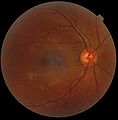Perifovea

Perifovea is a region in the retina that circumscribes the parafovea and fovea and is a part of the macula lutea.[1] The perifovea is a belt that covers a 10° radius around the fovea and is 1.5 mm wide.[2][3] The perifovea ends when the Henle's fiber layer disappears and the ganglion cells are one-layered.[4]
Additional images
-
Schematic diagram of the macula lutea of the retina, showing perifovea, parafovea, fovea, and clinical macula
-
Time-Domain OCT of the macular area of a retina at 800 nm, axial resolution 3 µm
-
Spectral-Domain OCT macula cross-section scan.
-
macula histology (OCT)
-
A fundus photograph showing the macula as a spot to the left. The optic disc is the area on the right where blood vessels converge. The grey, more diffuse spot in the centre is a shadow artifact.
See also
References
- ^ Myron Yanoff; Jay S. Duker (6 November 2013). Ophthalmology: Expert Consult: Online and Print. Elsevier Health Sciences. p. 421. ISBN 978-1-4557-5001-6.
- ^ Jasjit S. Suri (2008). Image Modeling of the Human Eye. Artech House. p. 133. ISBN 978-1-59693-209-8.
- ^ Vito Roberto (10 November 1993). Intelligent Perceptual Systems: New Directions in Computational Perception. Springer. p. 347. ISBN 978-3-540-57379-1.
- ^ Louis E. Probst; Julie H. Tsai; George Goodman (OD.) (2012). Ophthalmology: Clinical and Surgical Principles. SLACK Incorporated. p. 28. ISBN 978-1-55642-735-0.




